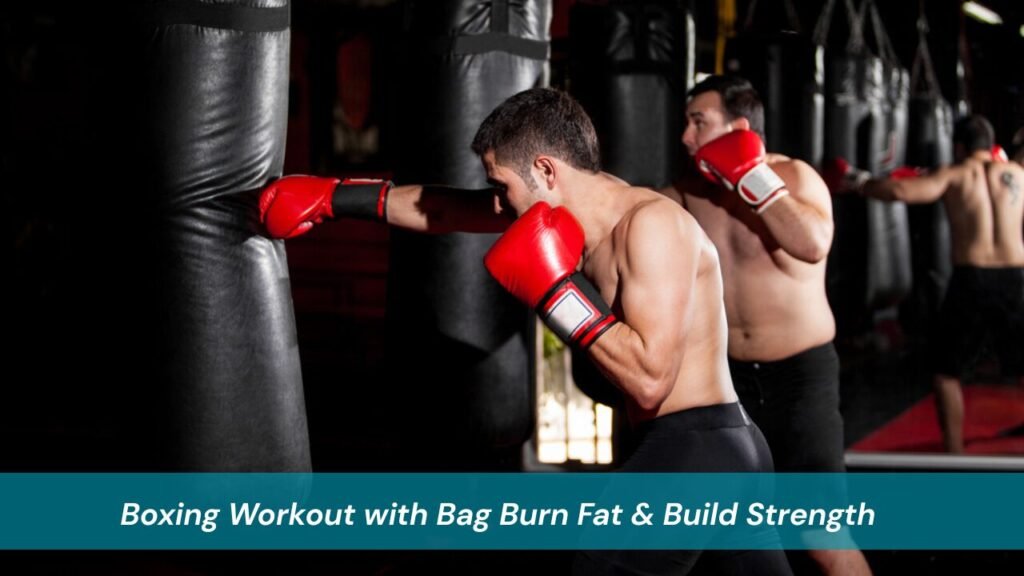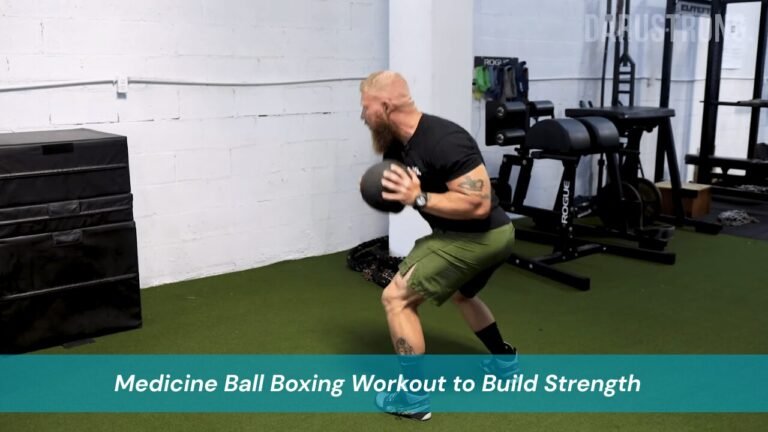Boxing has always been more than just a combat sport. It’s a way to push your limits physically and mentally while building discipline, endurance, and confidence. While many people associate boxing with sparring or pad work, one of the most accessible and effective training tools remains the heavy bag. A boxing workout with bag is not only a great way to develop striking technique but also an incredibly powerful method to improve overall fitness.
Whether you are a beginner stepping into the gym for the first time, a fitness enthusiast looking for a dynamic alternative to traditional cardio, or an experienced fighter sharpening your skills, bag training can be tailored to meet your specific goals. In this article, we’ll explore everything you need to know about bag workouts, from the fundamentals and techniques to sample routines and common mistakes to avoid. By the end, you’ll understand why the heavy bag is a cornerstone of boxing training and how you can use it to achieve real, lasting results.
Why Choose a Boxing Workout with Bag?
The heavy bag is often referred to as a boxer’s best training partner. Unlike shadowboxing, where you’re moving against air, the bag provides real resistance. That resistance forces your muscles to work harder, helping you develop both strength and striking power. Hitting a bag also helps condition your body to sustain repeated high-intensity efforts, much like what you would experience in a real boxing match.
Another reason the heavy bag is so effective is its versatility. A single session can target multiple areas of fitness. It strengthens the upper body through repeated punching motions, works the core every time you rotate your hips into a strike, and challenges your legs as you step, pivot, and maintain balance. At the same time, it provides a cardio boost that rivals running or cycling. A thirty-minute bag session can burn anywhere from 350 to 500 calories depending on your intensity level.
The benefits extend beyond the physical. Hitting the bag can be a major stress reliever. Many people describe it as a form of therapy, a way to channel frustrations and reset mentally after a long day. In addition, because boxing requires rhythm, coordination, and timing, bag work helps sharpen mental focus and improves reaction speed. These qualities make it not just a workout but also a skill-building practice that transfers into everyday life.
How to Start a Boxing Workout with Bag
If you’ve never trained on a heavy bag before, it’s important to start with the right equipment and preparation. The bag itself comes in different sizes, with standard weights ranging from seventy to one hundred pounds. For beginners, a medium-weight bag around eighty pounds is usually ideal, as it offers enough resistance without being too hard on the joints. Gloves are equally important. A good pair of twelve- to sixteen-ounce gloves provides protection for the hands and wrists, while hand wraps add another layer of support to prevent injuries.
Warming up before hitting the bag is essential. Unlike weightlifting, where you can start with lighter sets, bag training often begins with explosive movements that put stress on the shoulders and wrists. A solid warm-up should last about five to seven minutes. Jumping rope is one of the best ways to start, as it mimics the footwork patterns you’ll use in boxing while elevating your heart rate. Follow this with dynamic stretches such as arm circles, shoulder rolls, and light torso twists to loosen the upper body. Ending with a few minutes of shadowboxing will help you practice movement and combinations before transitioning to the bag.
Boxing Techniques You Should Practice on the Bag
Bag work is not about mindlessly throwing punches. It is about refining technique, building rhythm, and practicing the mechanics of real boxing. Every punch you throw should come from proper form, with the body working in unison to create power and accuracy.
The jab, or lead-hand punch, is often the foundation of boxing. It helps you measure distance, control your opponent, and set up more powerful shots. Practicing the jab on the bag allows you to focus on speed and accuracy, making sure you retract your hand quickly after each strike. The cross, usually thrown with the rear hand, is your power punch. On the bag, you should focus on rotating your hips and shoulders fully to maximize force.
Hooks are short, powerful punches that travel in a circular motion. They are excellent for developing upper body strength and should be practiced at both head and body level on the bag. Uppercuts, though more challenging on a heavy bag, are equally important. They train the ability to generate force from the legs and core, teaching you to punch from the ground up.
Defense is another essential part of bag training. Although the bag doesn’t punch back, you should practice slipping, rolling, and pivoting after combinations. This builds habits that carry over into sparring or real-life situations. By integrating offense and defense, you make your bag work more realistic and dynamic.
Sample Boxing Bag Workouts for All Levels
One of the best features of a boxing workout with bag is how customizable it can be. You can design sessions for beginners, fitness enthusiasts, or advanced boxers depending on your needs.
Beginner Routine
A six-round session is a great place to start. In the first round, throw simple jab-cross combinations at half power, focusing on form and breathing. In the second round, add hooks and body shots to create more variety. The third round should introduce defensive movement by slipping after each punch. By the fourth round, start integrating footwork with combinations, stepping around the bag instead of staying in one place. In the fifth round, focus on throwing with more force, paying attention to technique rather than speed. Finally, the sixth round can be freestyle, allowing you to mix everything you’ve learned while moving fluidly around the bag.
Fat-Burning Routine
For those primarily interested in weight loss, an eight-round high-intensity session works wonders. Each round alternates between periods of maximum effort and active recovery. For twenty seconds, throw rapid punches at the bag as fast as possible. For the next ten seconds, move lightly, keeping your hands up but throwing only light strikes. Repeat this cycle for the duration of the round. At the end of each round, push yourself to perform a thirty-second “punch-out drill,” where you throw nonstop punches until the bell rings. This method is extremely effective for burning fat and increasing cardiovascular capacity.
Advanced Power and Endurance Routine
Experienced athletes often train for ten rounds or more. The first three rounds should focus on speed, throwing crisp combinations with high volume. The next three rounds add heavy body shots and hooks, working on power generation. Rounds seven through nine are reserved for conditioning, with punch-out drills and sustained pressure against the bag. The final round should be a freestyle, maximum-effort round where you combine speed, power, and movement to simulate the demands of an actual fight.
How to Maximize Your Bag Training Results
To get the most from your sessions, always prioritize technique over sheer power. Throwing wild punches may feel satisfying in the moment, but it can lead to poor habits and even injury. Focus on using your legs and hips to generate force rather than relying solely on your arms. This not only produces stronger punches but also conditions the entire body.
Breathing is another critical aspect. Many beginners hold their breath while punching, which quickly leads to fatigue. Instead, exhale with each strike, allowing your body to stay relaxed and efficient. Tracking your progress can also keep you motivated. Record how many rounds you complete, the combinations you practice, or even how many punches you throw per session. Over time, you’ll notice improvements in stamina, speed, and power.
Finally, variety is key. Repeating the same workout over and over can lead to plateaus. Mix up your routines by changing the intensity, the focus (speed versus power), or the types of combinations you practice. This not only keeps training interesting but also ensures well-rounded development.
Mistakes to Avoid in Bag Workouts
Despite its benefits, bag training can be ineffective if done incorrectly. One of the most common mistakes is standing flat-footed. Good boxing relies on movement, and staying planted reduces both your power and your ability to evade. Another frequent error is overextending punches, which not only weakens strikes but also increases the risk of injury to the shoulders and elbows.
Some people also neglect defensive movement. Just because the bag doesn’t hit back doesn’t mean you should ignore defense. Incorporating slips, rolls, and pivots after combinations helps you develop the instinct to move automatically after attacking. Finally, avoid throwing punches without rhythm or control. Boxing is as much about timing and precision as it is about power. A wild flurry may look impressive but does little to improve actual skill.
Real-World Success Story
Professional gyms around the world, including the legendary Gleason’s Gym in New York, emphasize heavy bag training for both beginners and advanced fighters. Many athletes have credited consistent bag work with dramatic improvements in endurance and punch accuracy. Even outside of professional boxing, everyday fitness enthusiasts have seen remarkable results. For instance, some clients report losing up to twenty pounds in just three months by following structured heavy bag sessions combined with proper nutrition.
FAQs
Can I lose weight with heavy bag training?
Yes, heavy bag training is excellent for weight loss. The combination of high-intensity cardio and strength training helps you burn calories while building lean muscle. Paired with a healthy diet, it can lead to significant fat loss.
How many times per week should I train on the bag?
Most people see great results training three to four times per week. Advanced athletes or competitive boxers may increase this to five or six days, but recovery is just as important as training.
Do I need prior boxing experience to use a heavy bag?
Not at all. Beginners can start with basic punches like the jab and cross, gradually adding hooks, uppercuts, and defensive moves. With consistent practice, even someone with no prior boxing experience can quickly develop effective skills.
How long should each session last?
A typical boxing workout with bag lasts between thirty and forty-five minutes, including warm-up and cool-down. This length is enough to achieve cardiovascular benefits while leaving room for skill development.
Is bag training better than traditional cardio machines?
For many people, yes. While machines like treadmills and stationary bikes are effective, bag training offers a more engaging experience by combining cardio, strength, coordination, and skill-building into one workout.
Conclusion
A boxing workout with bag is one of the most efficient and rewarding ways to train your body and mind. It builds power, endurance, and technique while offering a cardio workout that is far from boring. By focusing on proper form, practicing both offense and defense, and following structured routines, you can unlock the full potential of heavy bag training.
Whether your goal is weight loss, improved fitness, or preparing for competitive boxing, the heavy bag provides the tools you need to succeed. The key is consistency. Wrap your hands, put on your gloves, and step up to the bag—it’s time to train like a fighter and unleash the benefits of boxing for yourself.




